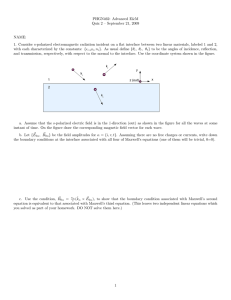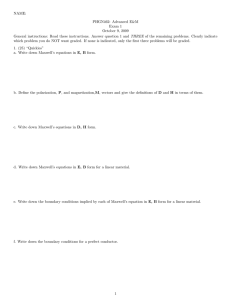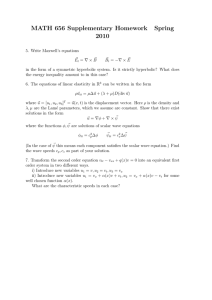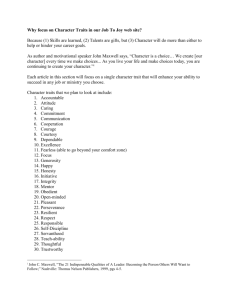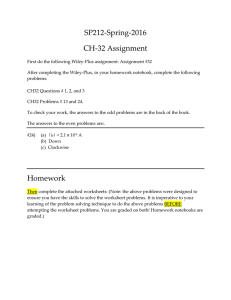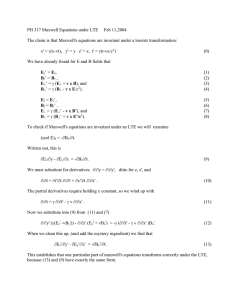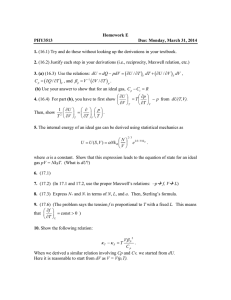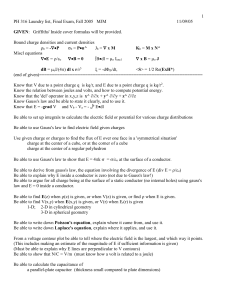NAME: KEY PHGN462: Advanced E&M Exam 1 October 9, 2009
advertisement
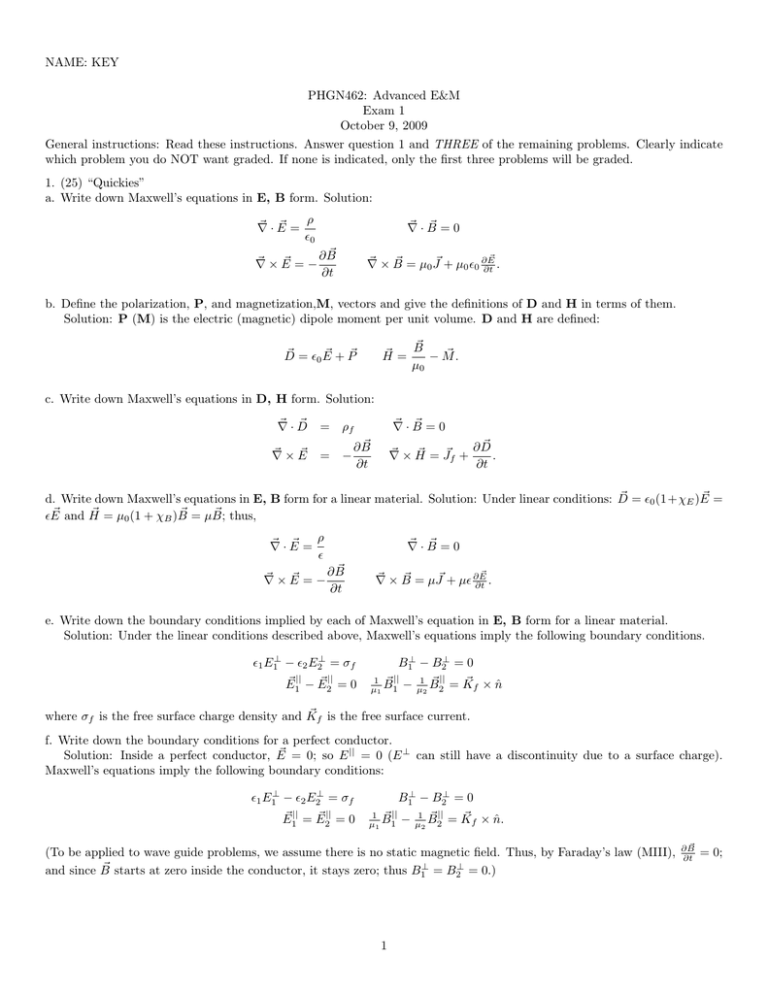
NAME: KEY
PHGN462: Advanced E&M
Exam 1
October 9, 2009
General instructions: Read these instructions. Answer question 1 and THREE of the remaining problems. Clearly indicate
which problem you do NOT want graded. If none is indicated, only the first three problems will be graded.
1. (25) “Quickies”
a. Write down Maxwell’s equations in E, B form. Solution:
~ ·E
~ = ρ
∇
0
~ ·B
~ =0
∇
~
~ ×E
~ = − ∂B
∇
∂t
~ ×B
~ = µ0 J~ + µ0 0 ∂ E~ .
∇
∂t
b. Define the polarization, P, and magnetization,M, vectors and give the definitions of D and H in terms of them.
Solution: P (M) is the electric (magnetic) dipole moment per unit volume. D and H are defined:
~
~.
~ = B −M
H
µ0
~ = 0 E
~ + P~
D
c. Write down Maxwell’s equations in D, H form. Solution:
~ ·D
~
∇
= ρf
~ ×E
~
∇
= −
~ ·B
~ =0
∇
~
~ ×H
~ = J~f + ∂ D .
∇
∂t
~
∂B
∂t
~ = 0 (1+χE )E
~ =
d. Write down Maxwell’s equations in E, B form for a linear material. Solution: Under linear conditions: D
~
~
~
~
E and H = µ0 (1 + χB )B = µB; thus,
~ ·E
~ =ρ
∇
~ ·B
~ =0
∇
~
~ ×E
~ = − ∂B
∇
∂t
~ ×B
~ = µJ~ + µ ∂ E~ .
∇
∂t
e. Write down the boundary conditions implied by each of Maxwell’s equation in E, B form for a linear material.
Solution: Under the linear conditions described above, Maxwell’s equations imply the following boundary conditions.
1 E1⊥ − 2 E2⊥ = σf
~ || = 0
~ || − E
E
1
2
B1⊥ − B2⊥ = 0
~ f × n̂
~ || = K
− µ12 B
2
1 ~ ||
µ1 B1
~ f is the free surface current.
where σf is the free surface charge density and K
f. Write down the boundary conditions for a perfect conductor.
~ = 0; so E || = 0 (E ⊥ can still have a discontinuity due to a surface charge).
Solution: Inside a perfect conductor, E
Maxwell’s equations imply the following boundary conditions:
1 E1⊥ − 2 E2⊥ = σf
~ || = E
~ || = 0
E
1
2
B1⊥ − B2⊥ = 0
1 ~ ||
1 ~ ||
~
µ1 B1 − µ2 B2 = Kf × n̂.
(To be applied to wave guide problems, we assume there is no static magnetic field. Thus, by Faraday’s law (MIII),
~ starts at zero inside the conductor, it stays zero; thus B ⊥ = B ⊥ = 0.)
and since B
1
2
1
~
∂B
∂t
= 0;
2. (25) Consider a parallel plate capacitor with circular plates of radius, R, and separation, d. Take R >> d, so you can
ignore any fringing. The capacitor at some instant of time has charge, Q, with current, I = dQ/dt, increasing the charge.
I
R
+
+
+
+
+Q
+
+
+
+
+
+
+
d
-
-
-
-
-
-
-Q
-
-
a. From Gauss’ law find the electric field inside the capacitor as a function of the charge, Q.
Solution: ConsiderHa “pillbox”
R Gaussian surface between the plates with end area, A, and with one end inside the conductor.
~ · d~a = dV ρ/0 , we have E · A = σ · A/0 = QA/(0 πR2 ). Thus, E = Q 2 .
From Gauss’ law, E
π0 R
b. What is the potential
R 2 difference between the plates?
~ Since E
~ · dl.
~ is constant between the plates, we get the potential difference between the plates,
Solution: Recall, V12 = − 1 E
Q
∆V = E · d = d π0 R2 . (The upper plate is at the higher potential.)
c. Use Ampere’s law to find the magnetic field between the plates of the capacitor at an arbitrary distance, r ≤ R, from
~
the center axis due to the displacement current (0 ∂ E/∂t)
as a function of the current, I.
H
R
~ = µ0 dA
~ · J~dis .
~ · dl
Solution: Consider an Amperian loop of radius, r, inside the capacitor. Ampere’s law states: B
Invoking symmetry, the left hand side gives, B2πr. Since the electric field is uniform across the area of the loop, we get
dQ
d
∂
(Eπr2 ). Plugging in our result from part a gives: 2πrB = µ0 0 πr2 dt
( πQ
for the right hand side: µ0 0 ∂t
2 ). Since I = dt ,
0R
µ0 Ir
B = 2πR
2.
~ = (E
~ × B)/µ
~
d. Calculate the power delivered to the capacitor by integrating the Poynting vector (S
0 ) over the area
surrounding the interior of the capacitor. Give your answer in terms of the charge and current.
~ = 1 (E
~ × B)
~ = 1 ( Q 2 )( µ0 I )(−r̂). Integrating the Poynting
Solution: In this example, the Poynting vector for r = R is S
µ0
µ0 π0 R
2πR
Qd
vector over the area surrounding the volume of the capacitor gives the total power: P = (2πRd) πR2QdI
0 (2πR) = I πR2 0 (which
is just IV ).
2
Ei
θi
1
θr
Er
ki
y
kr
z (out)
2
x
Et
kt
θt
4. Consider p-polarized electromagnetic radiation incident on a flat interface between two linear materials, labeled 1 and 2,
with each characterized by the constants: {i , µi , ni }. As usual define {θi , θr , θt } to be the angles of incidence, reflection,
and transmission, respectively, with respect to the normal to the interface. Use the coordinate system shown in the figure.
a. Assume that the magnetic fields are all in the ẑ-direction for all the waves at some instant of time (as shown in the
figure). On the figure draw the corresponding electric field vector for each wave.
~ 0i , B
~ 0i } be the field amplitudes for i ∈ {i, r, t}. Assuming there are no free charges or currents, write down the
b. Let {E
boundary conditions at the interface associated with all four of Maxwell’s equations (one of them will be trivial, 0=0).
Solution: Using θi = θr :
Maxwell I: 1 E1⊥ = 2 E2⊥ → 1 (Ei + Er ) sin θi = 2 Et sin θt
Maxwell II: B1⊥ = B p erp2 → 0 = 0
||
||
Maxwell III: E1 = E2 → (Ei − Er ) cos θi = Et cos θt
||
||
Maxwell IV: B1 /µ1 = B2 /µ2 → (Bi + Br )/µ1 = Bt /µ2
n 1 2
= nn21 µµ12 . (Don’t
n2 q
1
ni = 0i µµi0 to write:
c. Show that
Solution: Use
use Snell’s law.)
n1 2
=
n2 1
r
1 µ1 2
=
2 µ2 1
r
2 µ1
=
1 µ2
r
2 µ2 µ1
n2 µ1
=
1 µ1 µ2
n1 µ2
~ 0i = ni (k̂i × E
~ 0i ) and the result from part (c), to show that the boundary condition associated
d. Use the condition, B
c
with Maxwell’s first equation is equivalent to that associated with Maxwell’s fourth equation.
Solution:
θt
n1 2
MI: Ei + Er = 21 sin
sin θi Et = n2 1 Et
µ1
MIV: n1 (Ei + Er ) = µ2 n2 Et → (Ei + E + r) =
These are equal using the result from part (c).
n2 µ1
n1 µ2 Et
5. (25) The wave equation for sound in a hypothetical material is
∂ 2 φ(~r, t)
,
∂t2
where α and β are positive constants depending on the elastic properties of the material.
a. For this equation to be physically consistent what are the dimensions (units) of α and β?
~
(∇2 − ı~
α · ∇)φ(~
r, t) = β 2
(1)
Solution: Since ∇ has units of inverse length, to be dimensionally consistent we must have:
1/m2 = [β 2 /s2 ] → [β] = [s/m], or an inverse speed.
[α/m] = [1/m2 ] → [α] = [1/m], or an inverse length.
b. By evaluating the action of the wave equation on a plane wave traveling in the z-direction, eı(kz−ωt) , find the associated
dispersion relation, ω(k), for this material.
Solution: Plugging the plane wave form into the wave equation and taking the indicated derivatives gives:
~ ı(kz−ωt)
(∇2 − ı~
α · ∇)e
(−k 2 + αz k)
3
∂ 2 ı(kz−ωt)
e
∂t2
= −β 2 ω 2
= β2
which gives for the dispersion relation: ω =
k
β (1
− αz /k)1/2 .
c. What is the phase velocity for sound waves propagating in the z-direction?
Solution: The phase velocity is vp = ω/k = ()1−αz /k /β.
d. What is the group velocity for sound waves propagating in the z-direction?
Solution: The group velocity is given by:
vg =
∂ω
(k − αz /2)
=
.
∂k
β(k 2 − kαz )1/2
e. Find the cut-off wave vector, kmin , below which the wave will be exponentially damped in time.
Solution: The cut-off wave vector occurs when the ω becomes imaginary; that is, when k ≤ αz .
5. (25) Consider a hollow waveguide with a rectangular cross section of dimensions a × b. It is oriented along the z-axis
with the x-axis along the a side and y-axis along the b side. By z-translational symmetry, we may assume the electric and
magnetic fields take the form:
~ = E(x,
~ = B(x,
~
~
E
y)eı(kz z−ωt) ,
B
y)eı(kz z−ωt)
(2)
(Note the difference between the bold-face and normal-face vectors.)
a. Take the ŷ-component of Maxwell’s third equation and the x̂-component of Maxwell’s fourth equation, and,using the forms
above, solve for Ex and By in terms of {Ez , Bz } and the plane wave factors, {kz , ω}. Show all work.
Solution:
~
~ = − ∂B
~ ×E
MIII: ŷ · ∇
∂t · ŷ
∂Ex
∂z
~
~ = − 12 ∂ E
~ ×B
MIV: x̂ · ∇
c ∂t · x̂
∂B
y
z
− ∂E
∂x = − ∂t
Using the plane wave form for the z- and t-dependence gives
∂ ı(kz z−ωt)
∂z e
∂By
∂Bz
∂y − ∂z
ı(kz z−ωt)
= ıkz e
x
= c12 ∂E
∂t
∂ ı(kz z−ωt)
and ∂t
e
= −ıωeı(kz z−ωt)
∂Bz
ıω
z
ıkz Ex − ∂E
∂x = ıωBy
∂y − ıkz By = − c2 Ex
This is two equations for the two unknowns, {Ex , By }. Solve by substitution to find:
ω ∂Ez
∂Bz
k
−
z
(ω 2 /c2 − kz2 )
∂y
c2 ∂y
ı
∂Ez
∂Bz
Ex = 2 2
k
+
ω
z
(ω /c − kz2 )
∂x
∂x
By =
ı
b. Consider the special case of the transverse electric mode (Ez = 0). Assume the general solution of the z-component of the
magnetic field is:
Bz (x, y) = Bz0 [α sin(kx x) + β cos(kx x)] [γ sin(ky y) + δ cos(ky y)]
(3)
where {α, β, γ, δ} are constants and Bz0 is the amplitude of Bz (x, y). Using your result from part a, apply the boundary
condition that B⊥ be continuous across a boundary to find {γ, δ, ky }. Show all work.
Solution:
Since B⊥ = 0 inside the conductor, for B⊥ to be continuous across the surface of the conductor, By (x, y = 0) = 0 and
By (x, y = b) = 0. Using the expression above, and setting Ez = 0 for transverse electric modes, we have
By ∝
∂Bz
∝ [γ cos(ky y) − δ sin(ky y)] .
∂y
(The y-derivative doesn’t change the x-dependence.) Thus, applying the boundary conditions gives γ = 0 and ky =
integer. Finally, since Bz0 is the stated amplitude of the wave, δ = 1.
4
(4)
nπ
b ,
n
